Discovery of DNA structure and function is an interesting and fascinating story. Series of great Men and Women have contributed their life and knowledge in decoding the master molecule of life. Let us read it and pay tribute for their contribution.
We are very much aware that the structure of DNA was decoded by Watson and Crick. They were able to discover the structure of DNA based on the contribution of series of scientists. The stepping stone to discover DNA was laid by Robert Brown by discovery nucleus in 1831.
In 1869, Friedrich Miescher identified phosphorus rich containing material inside the nucleus. He also found that it is resistant to proteolysis. Miescher named this material as ‘Nuclein’. He discovered it while working on the leucocytes i.e. white blood cells present in the pus coated bandages. The Scientific community took almost 50 years to accept his contribution.
Later the thread of Discovery of DNA was carried forward by Russian biochemist Phoebus Levene. He was the first to discover the components of nucleotide and difference of sugar moiety in DNA and RNA (deoxyribose and ribose respectively). IN 1919, he had proposed that DNA could be polymer of nucleotides.
Discovery of DNA: Griffith Experiment –
In 1928, Gregor Mendel studied the traits of plants and the pattern of their inheritance. The Mendel contribution was a pioneering work for discovery and understanding of inheritance. After the Mendel’s discovery of principle of inheritance, the science community was curious to find the factors that are responsible for transferring the characters from one generation to another. The Scientists were keen to identify the molecule responsible for the inheritance. Let’s see the how Griffith performed his experiment and proved that DNA is a genetic material.
Frederick Griffith, a British Bacteriologist conducted a series of experiment on Streptococcus pneumoniae and mice. He was attempting to develop vaccine against pneumonia. In this experiment, he used two strains (R and S) of Streptococcus pneumoniae.
The R stands for rough. The R strains when grown on petri plate their colonies have rough appearance. They are found be non pathogenic i.e. they do not cause any disease.
The S stands for smooth. When S strains are grown on petri plate, their colonies appear to have smooth surface. The smooth surface is the due to the ability of this strain to produce polysaccharide capsule. The presence of capsule allows the bacteria to protect them from host immune system causing pneumonia disease. Hence, they are pathogenic i.e. they cause disease.
He performed following experiments –
1. He injected R strain in the mice and found that it did not cause any disease. And mice remain alive.
2. He injected S strain in the mice and observed that mice died due to the infection of pneumonia.
3. He injected heat killed S strain in the mice and observed that mice remained alive. With this, he concluded that heat kills the pathogenicity of S strain.
4. He injected R strain and heat killed S strain into mice. He expected mice to stay alive because R strain and heat killed S strain are non-pathogenic. But surprisingly, the mice died. When Griffith studied the blood sample of died mice, he observed the living S strain bacteria.
He was amazed to see the live S strain bacteria. Based on his series of experiment he concluded that R strain (non-pathogenic) took something from heat killed S strain (non-pathogenic) and become pathogenic. Hence, the bacteria got transformed. Griffith called it transforming principle, which transformed the non-pathogenic R strain to pathogenic S strain.
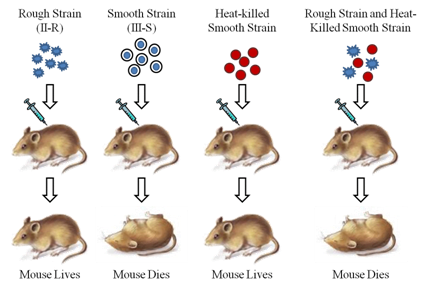
Chargaff –
In late 1940s, Chargaff used paper chromatographic technique and discovered that nucleotide composition varies among species. He also stated that the characteristics of DNA is same in all types of organisms. He added that content of adenine is equal to thymine and guanine is equal to cytosine i.e. total amount of purine is equal to total amount of pyrimidine. His observations are called as Chargaff rule.
Discovery of DNA: Avery, McCarty, and MacLeod –
After Griffith experiment, the chemical nature of the transforming particle remained a mystery. In 1944, Oswald Avery, Maclyn McCarty, and Colin MacLeod performed the same experiment of Griffith but with different approach. The cell is made up of five major types of biomolecules namely DNA, RNA, protein, lipid or carbohydrate. They hypothesized that transforming particle could be DNA, RNA or protein. And to test it, they prepared the heat killed S strain culture and removed the carbohydrate and lipids.
They prepared three different sets containing DNA, RNA and protein. They wanted to test the transforming ability of these biomolecule individually. In order to do so, they used digestive enzymes to destroy unwanted biomolecule.
Set I was treated with proteinase. The proteinase enzyme digests and degrades the proteins leaving behind DNA and RNA. In this, R strain was added and it was injected into mice. They found that R strain was able to transform into S strain causing pneumonia and death. It means, protein is not responsible to transformation
Set II was treated with RNase. The RNase enzyme degrades the RNA leaving behind DNA and protein. The suspension was missed with R strain and it was injected into mice. They found that R strain was able to transform to S strain causing pneumonia and death. They concluded that RNA is not responsible for transformation.
In Set III, DNase were added and they degraded the DNA molecule leaving behind RNA and protein. The suspension was mixed with R strain and injected into mice. They found that mice remained alive and did not get any diseases. With this they concluded that DNA is responsible to transforming the R strain into S strain. And hence, DNA is genetic material.
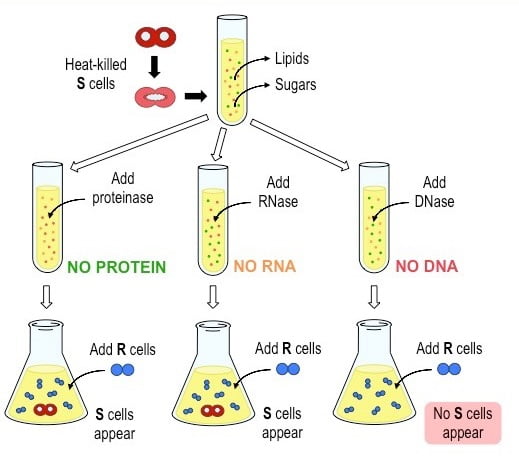
Discovery of DNA: Harshey & Chase experiment –
Even after the successful experiment of Oswald Avery, Maclyn McCarty, and Colin MacLeod, the scientific community denied to accept that DNA is a genetic material and it is responsible for inheritance. In 1952, Harshey and Chase conducted an experiment and proved the same. They conducted experiment on bacteriophage, a virus that infects bacteria.
The structure of bacteriophage is simple and it is made up of DNA and protein. The DNA is enclosed in the protein capsid. The bacteriophage infects the bacteria by attaching it to bacterial surface and injects the infecting particle (either DNA or protein). In order to solve the mystery, Harshey and Chase prepared two different batches of bacteriophage. In one batch, they radiolabelled the DNA while in other radiolabelled the protein. The DNA was labeled with 35S and DNA was labeled with 32P isotope.
Both the radiolabelled batches were allowed to infect the bacteria. After the infection, both the infected cultures were blended in order to remove the attached phage or its part from bacterial cells. Blending was followed by centrifugation to separate bacteria and phage debris. Bacteria being heavier than virus, it gets settled at the bottom the centrifuge tube forming pellet and virus remains in the supernatant.
Harshey and Chase observed that 32P appeared in the pellet with bacteria and 35S was in supernatant. Based on this observation, Harshey and Chase concluded that DNA enters the bacteria and it is responsible for causing infection. Hence, it is the genetic material.
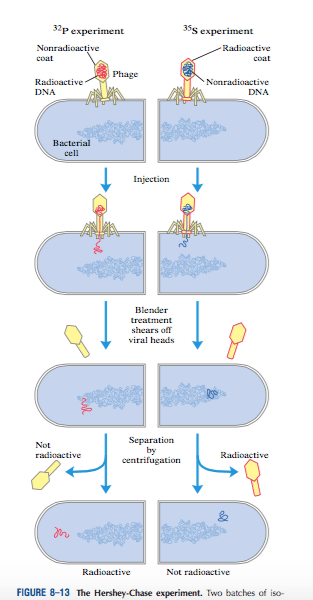
Discovery of DNA: Structure of DNA –
The discovery of DNA structure was done by James D. Watson and Francis Crick in 1953 based on the data of Maurice Wilkins and Rosalind Franklin X-ray Crystallography of DNA.
They explained following characteristics of DNA –
- DNA is a double helical structure. The two strands are coiled around a common axis. The structure looks like a twisted ladder.
- Each strand is a polymer of nucleotides with a 5’ (phosphate group) and 3’ end (hydroxyl group). The repeating unit is nucleotides. The nucleotides are linked to each other by phosphodiester bonds.
- The nucleotides are made up of sugar, phosphate and nitrogen bases (Adenine, Guanine, Cytosine and Thymine).
- The sugar-phosphate acts like backbone and nitrogen bases protrude out.
- The structure looks like a twisted ladder, where the sugar-phosphates looks like sides of the ladder and nitrogen pairs seem to be steps.
- Both the strands are antiparallel i.e. they run in opposite directions.
- The two strands are held together by hydrogen bonds present between complementary nitrogen bases.
- The diameter of the helix is 2nm (20Å).
- The length of one turn is 3.4nm (34Å). One turn consists of 10 base pairs.
- The DNA helical structure has asymmetric grooves called major and minor grooves. The major groove is larger than minor. The difference is due to the geometrical configuration of the nitrogen base and the bonds between them.
- The major and minor grooves exposed the bases. Hence, the size of the groove is critically used by the DNA binding proteins to recognise specific sequences of the DNA.
Meselson and Stahl Experiment –
Once, it was discovered that DNA is the genetic material and it is double helical in structure. The scientific community was curious to find how this genetic material copy itself and how is it transferred from one generation to another. Knowing that, the two strands are complementary to each other, it was understood that during replication, they separate from each other; and they act like template for synthesis of new or daughter strand. Hence
During that time, three models were proposed to discovery of DNA replication.
1. Conservative – According to this model, after replication one DNA molecule consists of parental strands and other DNA molecule consist of both new and daughter strands.
2. Dispersive – According to this model, after DNA replication both the DNA molecule consists of mixture or hybrids of parental and daughter DNA. It means, both the DNA are patchwork of parental and new DNA.
3. Semi-conservative – According to this model, the two strands get separate and acts like template. The new or daughter DNA is synthesized based on the complementary relation. Hence, after replication, both the DNA molecule has one parental and one daughter strand.
Meselson and Stahl conducted experiment on E.coli. They grew the bacteria on the nutrient media with heavy isotope of nitrogen 15N. The bacteria uses nitrogen element for the synthesis of protein, DNA and other important biomolecule. When bacteria are grown for many generations, bacteria used the heavy nitrogen for nitrogenous base of DNA. Eventually, the whole DNA has heavy nitrogen.
Later, they switch the bacteria to 14N medium and allowed to utilize it for next several generations. Hence, the new DNA is made of 14N isotope.
Knowing the generation time of E.coli, Meselson and Stahl collected a small bacterial sample in each generation and purify the DNA. Followed by measuring the density of DNA by density gradient centrifugation.
The density gradient method separates the molecules based on their molecular density. The centrifuge tube has gradient of cesium chloride from top to bottom. The 14N and 15N has different density and hence they settle different bands of cesium chloride.
The Meselson and Stahl observed and studied the first four generations-
The bacterial sample collected just before switching the media is called zero generation. That media contains 14N nitrogen. When the sample was centrifuged, they observed a single band. It is because the bacteria carried only one type of isotope of nitrogen.
The bacterial sample collected after the switching the media from 15N to 14N is called as first generation. When it was centrifuges, they observed single band. And the band was intermediate in the density of heavy 15N and light 14N. It means it was hybrid of both. The intermediate band disapproves the theory of conservative. Because, according to conservative model, two bands should have been appeared, one band of 15N parental and other of 14N daughter DNA.
The second-generation bacterial sample was collected and DNA was isolated and centrifuged. They observed two bands. The one band was in intermediate position while the other was a bit higher. The intermediate band was of 14N and 15N and the higher band was of light 14N. This observation rejected the dispersive model, because according to this model, the parental and daughter DNA carries patches of both. Therefore, there should not be any pure band of 14N. Moreover, they observed that every generation, the band was becoming lighter and hence, the replication is expected to be of semi conservative type.
Based on the second-generation observation, it was expected that hybrid DNA to give an intermediate and light band. But in second and third generation, more light bands were observed. It was also observed that the intermediate band was becoming lighter and the light band was progressively becoming darker.
This experiment concluded that DNA replication follow semi-conservative mode of replication. After replication, both the DNA molecules carry one parental and daughter strand.
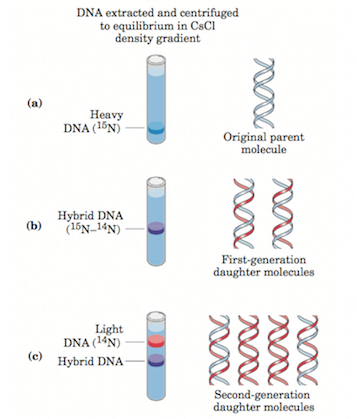
Central Dogma of Molecular Biology –
This principle was proposed by Francis Crick in 1958. He stated that the information stored in DNA is converted into protein as a functional product. The central dogma explains the process of conversion of genetic information into protein. The vital information is stored in DNA in the form of a sequence of codons called genes. This message is transcripted into m-RNA, it is called gene expression. The process of forming m-RNA from DNA is called Transcription because the message is written in the same language i.e. language of nucleotide sequence (DNA and RNA are polynucleotide chains). Hence, it is called Transcription. The messenger RNA acts like postmen and carries this information from nucleus to cytoplasm. m-RNA reaches the ribosome because the ribosome is the site for synthesis of protein. The t-RNA has the ability to read this secret message and translate it into protein. While, the information in RNA is converted to protein (amino acid chain), changing the language from nucleotide sequence to amino acid sequence.
The central Dogma also explains the ability of DNA to form its copy by the process of replication. The copy of DNA is required in order to inherit in the next generation.
References-
- Nelson, D. L., & Cox, M. M. (2017). Lehninger principles of biochemistry (5th ed.). W.H. Freeman.
- Lodish, Harvey F. Molecular Cell Biology. 4th ed. New York: W.H. Freeman, 2000.
- Karp, Gerald. Cell and Molecular Biology: Concepts and Experiments. New York: J. Wiley, 1999.
- https://www.nature.com/scitable/topicpage/dna-structure-and-function-watson-397/
Dr. Sangha Bijekar has 9 years of Teaching Experience at University level. She loves to get engage in teaching and learning process. She is into blogging from last two years. She intends to provide student friendly reading material. She is avid Dog Lover and animal rescuer. She is learned Bharatnatyam and Katthak Dancer. She is into biking and She also loves to cook.
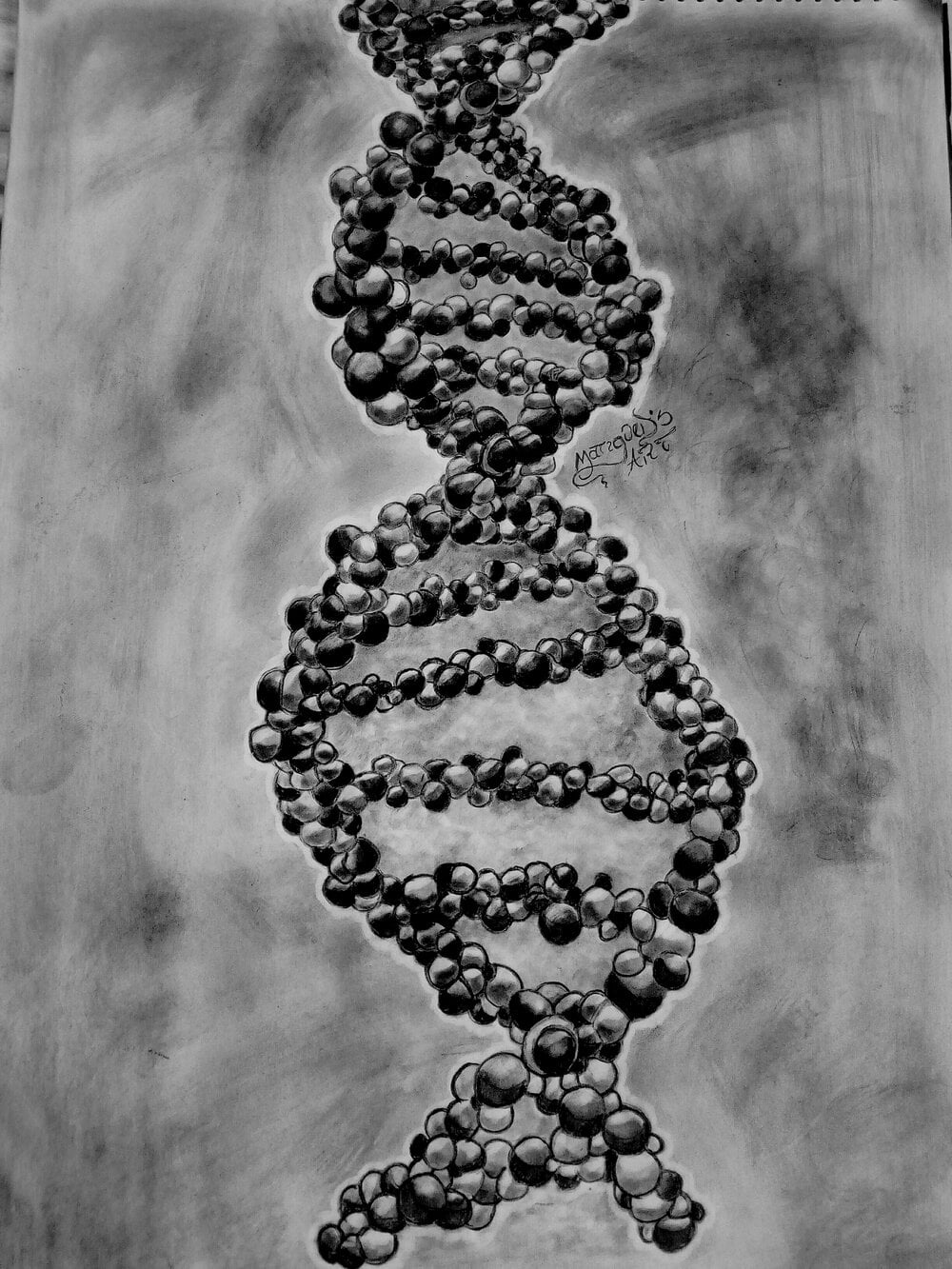
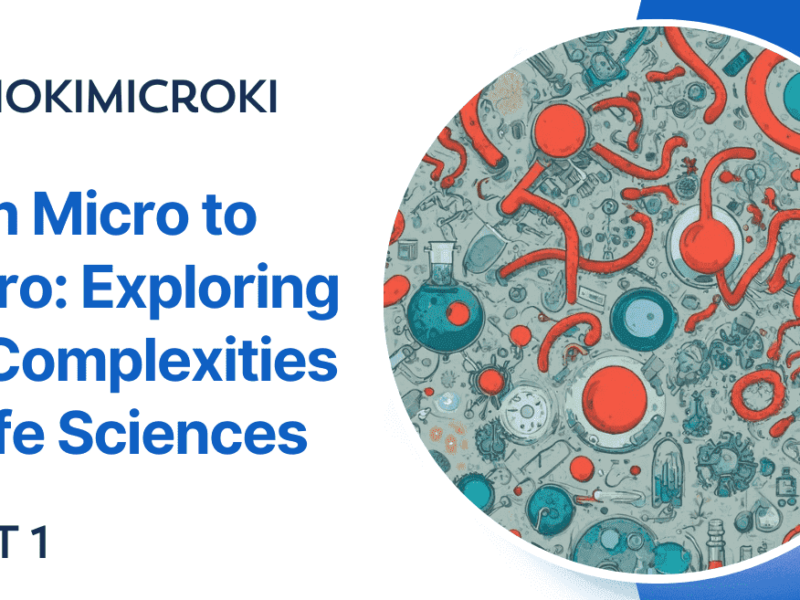

3 thoughts on “Discovery of DNA – Master Molecule of Life”